Volkswagen ID.3 Pro Performance review
Picture, if you can, a Nissan Leaf with longer driving range, higher efficiency, quicker charging, superior refinement and more attractive design that’s also better fun to drive. Actually, don’t bother straining your imagination; just take a look at the Volkswagen ID.3.
This practical, Golf-size five-door EV is all the things listed above, making the Volkswagen ID.3 arguably the best small EV on sale in the world today… but not that part of the globe labelled Australia.
In Europe, where it went on sale in September 2020, the VW has been a big hit. It’s a regular contender at the top of EV sales charts there, and VW is racing to keep up with demand.
Its German factories in Zwickau, which only makes EVs, and Dresden are turning out 1200 a day. Recently the company’s Anting plant started producing the ID.3 in China for that market.
Even though global production is ramping up, Australians cannot buy the ID.3 and there’s no sign of this situation changing. The explanation from VW Group Australia is that Volkswagen HQ in Germany has a policy of prioritising supply of EVs to markets with legally binding national emissions targets.
To discover exactly what Australians are missing out on, EV Central borrowed an ID.3 from VW Italy for a week.

Value theory
The ‘1st’ badge worn by the white ID.3 means launch edition. It’s no longer available, having been effectively replaced by the Pro Performance model with exactly the same tech and spec.
The Pro Performance’s 58kWh battery pack and 150kW electric motor place it around the middle of the ID.3 line-up in Europe. There are more expensive variants with 77kWh packs, and less costly versions with 45kWh packs and a less powerful motor.
In Italy the ID.3 Pro Performance is €38,900, before government incentives are deducted. This price is less than a Nissan Leaf e+ with a similar-size 56kWh battery pack and equivalent equipment level to the single variant of sold in Australia.
This translates to a theoretical sub-$60,000 ID.3 Pro Performance price in Australia, before on-road costs and fees are added. Crucially, the price of the Volkswagen would be well below the cut-off point for state government EV rebates.
Looking at the other versions, the 45kWh ID.3 Pure Performance would cost around the same as a basic $50,000 Leaf with its 37kWh of usable battery capacity, while the top the 77kWh ID.3 Pro S could just sneak under the $68,750 price cap to qualify for the EV rebates in NSW and Victoria.
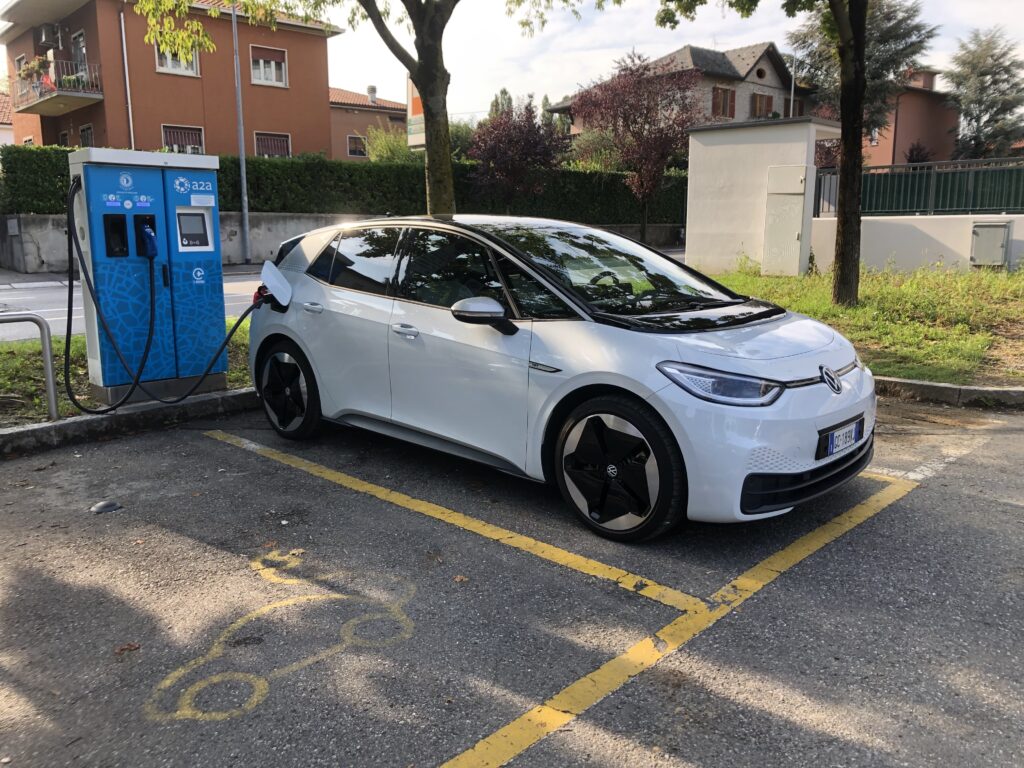
Range and charging
While the WLTP-rated range of the ID.3 Pro Performance is 426km, the real-world number is more like 350km. As with an ICE-powered car, the kind of driving you do has a big effect on driving range.
In a mix of city, suburban and country road driving on a mild day, our test ID.3 consumed energy at a rate 14kWh/100km. This indicates a 410km driving range on a fully charged battery pack.
Consumption on Italian autostrada, where the speed limit is 130km/h, was much higher. At a little over 20kWh/100km, this would cut the VW’s driving range to less than 300km.
The independent experts who compile Europe’s excellent EV Database website rate the ID.3 Pro Performance’s real world range from a minimum of 250km (motorway driving in cold weather) to a maximum of 515km (city driving in mild weather). Our time with the VW makes us think these numbers are realistic.
For comparison, EV Database rates the driving range of the Nissan Leaf e+ from 230km to 485km.
The Volkswagen beats the Nissan by an even larger margin when it comes to charging. All ID.3 models are equipped with an on-board 11kW AC charger.
In the case of the Pro Performance this means a 0-100 percent recharge will take a little over six hours. When hooked up to an 11kW or better wallbox, of course. The Leaf e+ has a 6.6kW AC charger, which extends the time for a full recharge to 10 hours.
The ID.3 Pro Performance can take a maximum of 125kW from a DC fast charger, meaning a 10-80 percent charge will take around 30 minutes. The Leaf e+, with its 100kW DC charging maximum, will take longer.
The Volkswagen ID.3 has the CCS Combo charging port favoured by the majority of European car makers.
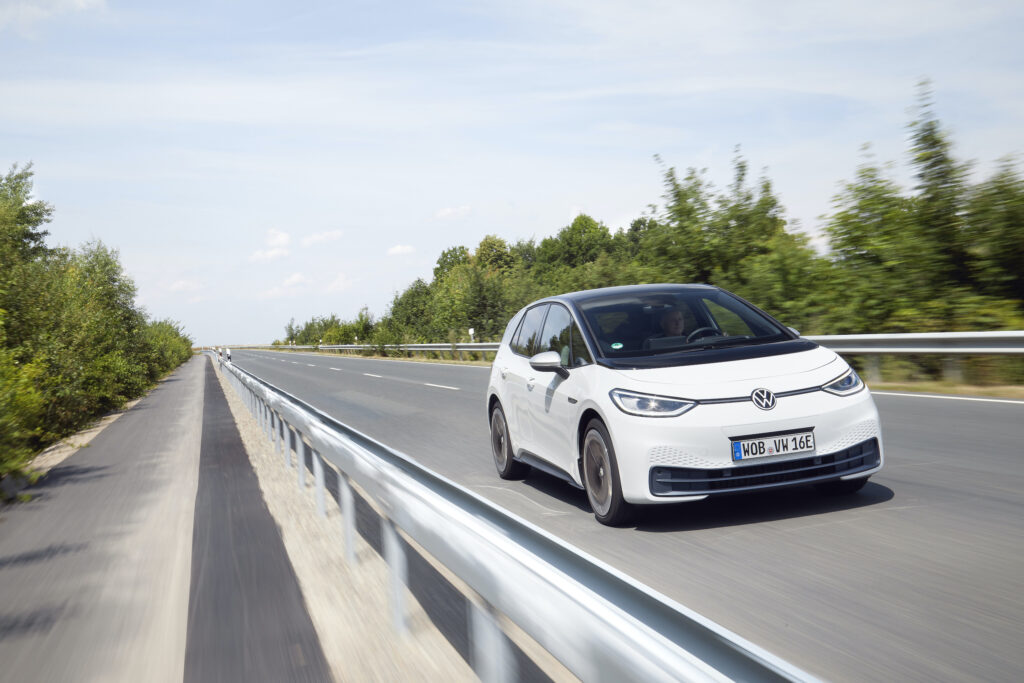
Go and whoa: Volkswagen ID.3 performance
The Pro Performance’s single synchronous permanent magnet motor delivers power and torque maximums of 150kW and 310Nm.
Though these numbers are slightly less than the e+’s 160kW and 340Nm, the ID.3 takes the same time, 7.3 seconds, to accelerate 0-100km/h. The top speed of both cars is capped at 160km/h.
Still, the Pro Performance is the quickest variant in ID.3 range. It feels lively from standstill, but once rolling performance is brisk rather than breathtaking.
VW doesn’t think one-pedal driving is a great idea. The ID.3’s gear selector sprouts like an ear from the right side of the digital instrument display, an easy reach from the steering wheel. It works the same way as the similar device used by BMW in the i3; twist forward to go forward, back to reverse, press for Park.
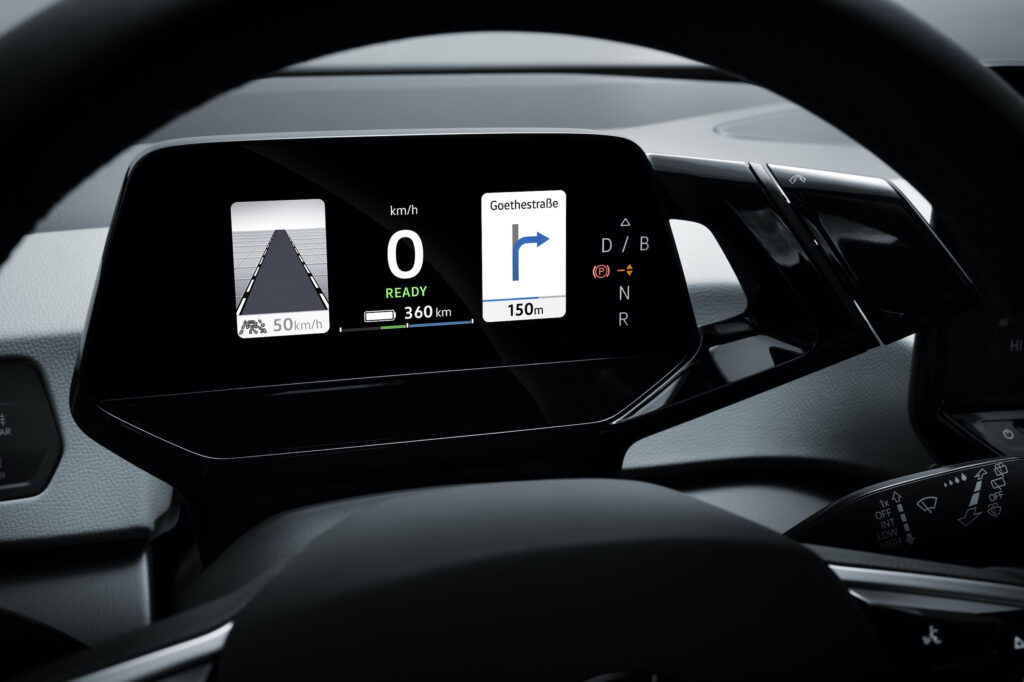
In D regenerative braking is quite mild. Twisting the selector forward a second time switches to B. As in a Toyota hybrid, this increases the level of regenerative braking to mimic the effect of engine braking in a conventional ICE-powered vehicle. But it doesn’t go as far as the fairly aggressive level of braking felt using one-pedal mode in, say, a Nissan Leaf.
My personal preference is for mild regenerative braking, so I liked the way the ID.3 behaved when the accelerator was released in D. The brake pedal, by the way, hides the transition between regenerative and friction braking really well in harder stops.
The ID.3’s powertrain is also very quiet, even by EV standards. The VW is quieter than more costly EVs such as the Volvo XC40 Pure Electric and Polestar 2. The ID.3 motor’s location, in the rear axle below the cargo compartment, probably helps here. But the silence and smoothness also show that VW’s engineers paid a lot of attention to eliminating motor, gear and inverter noises.
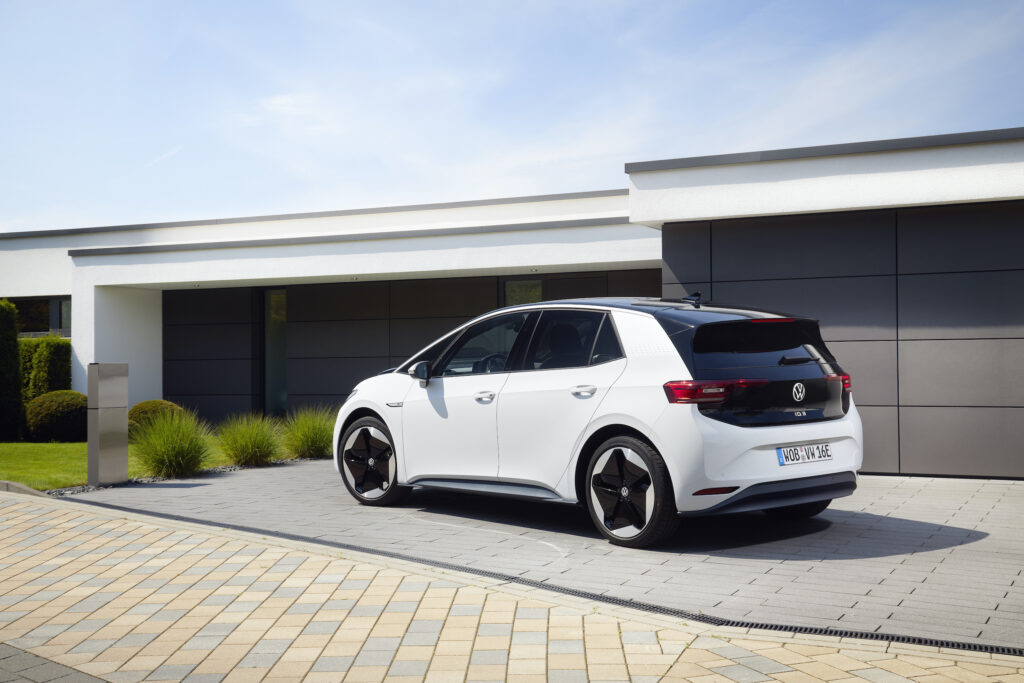
Inside the ID.3
At 385 litres, the cargo compartment above the ID.3 single motor is a good size. The interior is spacious, too.
The ID.3 is built on VW’s purpose-designed EV architecture, MEB. It has a longer-than-normal small-car wheelbase and the battery pack installed beneath the passenger compartment means the cabin floor is flat.
There’s lots of rear-seat legroom, while head room is more than adequate. Up front the seats are comfortable and have a good range of adjustment. The steering column is adjustable for both angle and reach (unlike the Leaf), and finding a perfect driving position is easy.
Designers have given the ID.3 a minimalistic look by reducing the number of physical buttons. There’s no Start button, for example. As in some other EVs, simply sitting in the driver’s seat, either with the key in your pocket or dropped into the centre console, is enough to wake the ID.3.

This is fine, but button-clutter reduction also means the centre screen has an increased workload. There’s an array of touch-sensitive buttons beneath the screen for basic functions from heating to hazard lights, and more controls on the steering wheel, but the touchscreen still needs to be used fairly frequently.
The problem is that the menu structure isn’t well designed. Doing simple stuff is often a hunt-and-peck multi-tap operation. Though you quickly get fairly familiar with it, it remains needlessly complicated and time-consuming to use.
An example? The ID.3’s annoying lane-keeping system is on by default at start-up, and switching it off isn’t intuitive or speedy.
The quality of the screen itself, on the other hand, is very good, especially the larger 12-inch display standard in the Pro Performance. And the ID.3 has both Apple CarPlay and Android Auto.
There are two USB ports up front, plus an inductive smartphone charging pad. For those in the rear seat there are two power-only USB ports.
The standard of materials and assembly are good, if not quite in the same elevated league as, say, the Volkswagen Golf. There’s not a lot to entertain the eye but the overall design is pleasing if bling isn’t your thing. And the ID.3’s interior is much classier than the Leaf, which looked and felt old-fashioned the moment it launched.
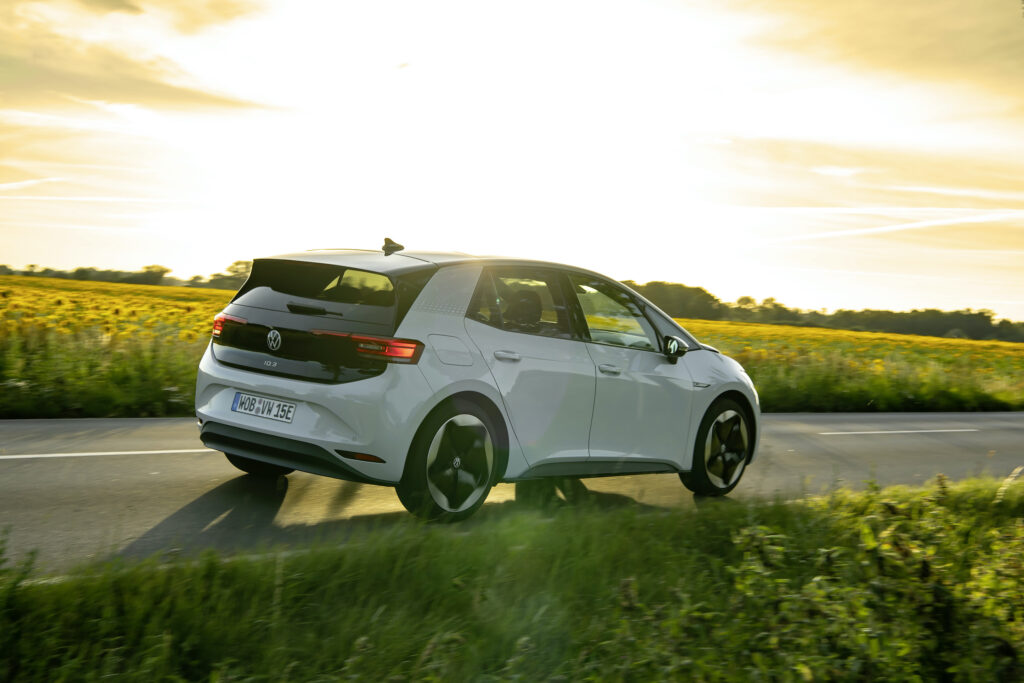
Ride comfort and handling
Disciplined dampers keep the front strut and multilink rear suspensions of the ID.3 under firm control. It doesn’t ride like a limo, in other words, but it’s at all not uncomfortable. Nor is it a floaty flounderer when hurried through a corner.
From the driver’s seat the benefits of the VW’s rear-drive layout can be sensed. There’s none of the tugging through the steering wheel when accelerating that’s fairly common in front-drive cars. It has good traction when driving out of corners, too. And the turning circle is nice and tight.
With 50:50 weight distribution, the 1800kg-plus ID.3 feels nicely balanced when cornering, with both ends of the car contributing equally to overall grip.
But the VW has the handling talent to handle more grip than the 215/45 20-inch Bridgestone Turanza Eco tyres of our tester could give. These put a lowish limit on the cornering speeds the ID.3 can sustain.
Even so, when pushed to the limit, the VW is quite benign. It will understeer a little when asked to turn in at a too-high speed, and will oversteer a little if the driver is aggressive with the accelerator when exiting a corner. Either way, the car’s electronic stability control acts promptly to curb the slippage.
Driven within its limits, though, the ID.3 can be made to flow sweetly on a winding road. It’s quite good fun to drive, in fact. But the VW shines brightest while cruising, when its silence, smoothness and sophistication can be savoured.
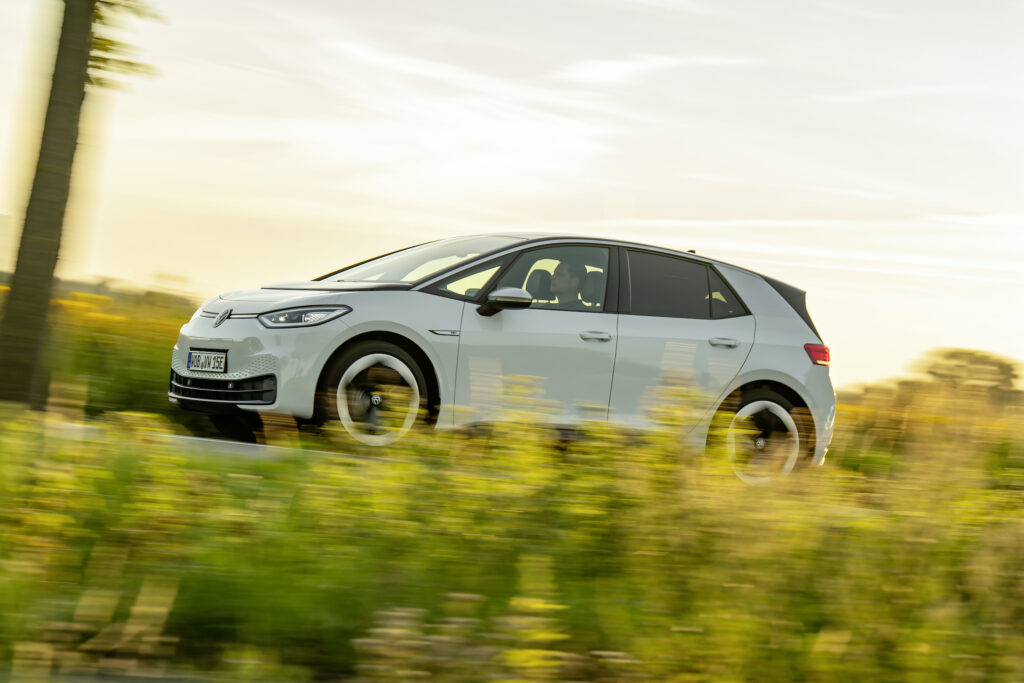
Verdict
The ID.3 is probably the best small EV out there. With its spacious interior, smart rear-drive layout, energy efficiency and charging tech it outpoints its most obvious rival by a large margin.
Australia needs more relatively affordable EVs like the ID.3. They’re exactly what’s needed to accelerate the shift to electro-mobility.
Though the VW EV might never make it here, Australians will be able to buy an ID.3 wearing a different badge from late in 2022. Young VW-owned and Barcelona-based brand Cupra will arrive in Australia in the middle of next year with a three-car range that includes a couple of PHEVs.
Just a few months later it aims to add an EV to the line-up… and the new Cupra Born is basically an ID.3 Pro Performance with added Spanish spice. Cupra Australia has given a strong indication the Born could come here in 2023 priced from about $50,000.
2021 Volkswagen ID.3 Pro Performance specifications
Price: About $60,000 in Europe
Basics: EV, 5 seats, 5 doors, small hatchback, RWD
Range: 426km (WLTP), 350km real world range
Battery capacity: 58kWh
Battery warranty: 8 years/160,000km (guarantee of 70 percent of original battery capacity)
Energy consumption: 13.6kWh/100km (WLTP), 16.6kWh/100km real world
Motors: 1 rear, 150kW/310Nm
AC charging: 11kW, Type 2 plug
DC charging: 125kW, CCS Combo plug
0-100km/h: 7.3 seconds (claimed)


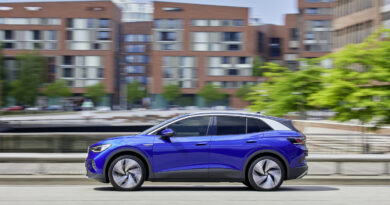
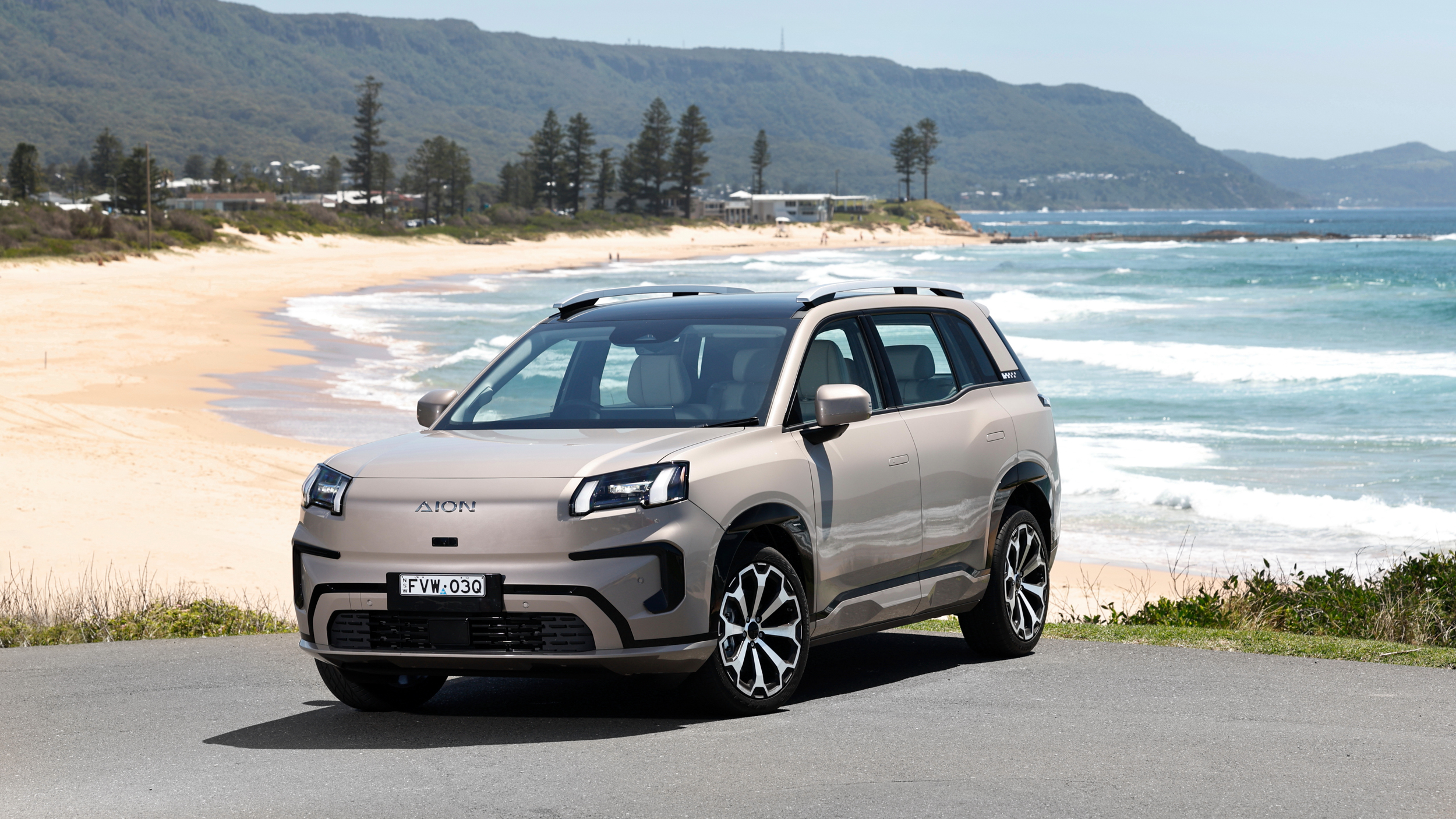
An excellent review, John and it reinforces the tragedy of VW EVs not being available here!
I only take issue with one point in your article: the disparaging remarks about lane-keeping assist (LKA). Toby Hagon has expressed a similar opinion on ABC radio. I haven’t driven an ID.3 but my Kona Electric has LKA and I think it is great. It is subtle and only nudges you gently back into your lane – which is exactly what it’s supposed to do. It’s easily over-riden if necessary, by using a bit more force on the steering wheel. If LKA prevents a few fatal head-on collisions it has easily proven its worth. I concede that it is not perfect; but for example on twisty, narrow roads it can temporarily be turned off. Otherwise on most roads and especially on motorways it is great technology in my opinion.